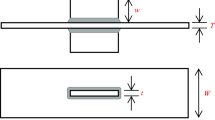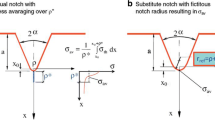Abstract
This paper presents the results of three phases of fatigue tests for the fatigue strength of in-plane welded gusset joints which are most common details inevitably existed in the region of high stress range. Totally fifty seven fatigue specimens with various thickness and strengths were made and the tensile fatigue tests were performed. One full scale beam fatigue tests was also carried out. The validity of the fatigue strengths of those details in specification was proved and the effects of thickness of flanges and welded attachments, length of attachments and the strength of applied steel were examined. The characteristics of crack initiation and propagation were also observed. The test results are evaluated by comparing with other test data and the fatigue criteria of other countries. In order to find out the degree of stress concentration in the weld toe depending on geometric configuration such as the attachment length and transition radius, analytical works were also carried out. Comparing with present specification, analytical results indicate that there are need of revising and subdividing the detail categories.
Similar content being viewed by others
References
American Association of State Highway and Transportation Office, (2002) “Standard Specifications for Highway Bridges”. Washington D.C.
Bae, D. (2002). “Fatigue Strength of welded Gusset Plate Using High Performance Steet”.Engineering Journal in Kookmin University Seoul, pp. 287–292.
Bae, D., Jung, K., and Joe, J. (1999). “Fatigue Test for Steel Bridge Details II (Fatigue Test of Bridge Details with Welded Thick Members)”Research Report 99-1, KSSC, Seoul.
Bae, D and Kim, S. (2001). “Usability Evaluation of High Performance Steel”.Research Report 01-1, KSSC, Seoul.
Demers, C. and Fisher, J.W. (1990). “Fatigue Cracking of Steel Bridge Structures”. FHWA-RD-89-166, Washington D.C.
Fisher, J.W., Mertz, D.R., and Zang, A. (1983). “Steel Bridge Members under Variable Amplitude Long Life Fatigue Loading”. NCHRR 267. Washington D.C.
Jung, K., Joe, J., and Bae, D. (1998). “Fatigue Test for Steel Bridge Details I”.Research Report 98-1.KSSC, Seoul.
Korea Road Transportation Association (2000). “Korean Highway Design Code”. Seoul.
Yen, Ben T. and Fisher, J.W. (1990). “Mannual for Inspecting Bridges for Fatigue Damage Conditions”. Fritz Eng. Lab. No511.1 Lehigh University, Bethlehem.
Author information
Authors and Affiliations
Corresponding author
Rights and permissions
About this article
Cite this article
Bae, D. Experimental study on fatigue strength of in-plane welded gusset joints. KSCE J Civ Eng 8, 89–93 (2004). https://doi.org/10.1007/BF02829085
Received:
Accepted:
Issue Date:
DOI: https://doi.org/10.1007/BF02829085




